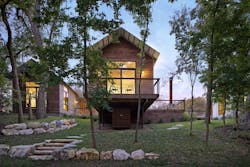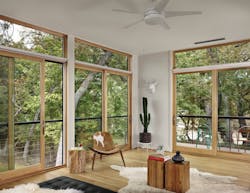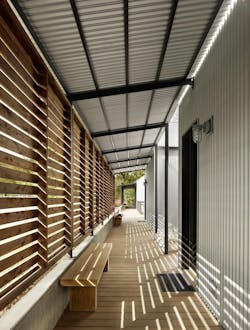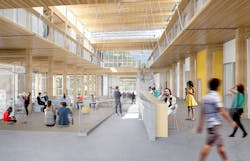Design for manufacturing
For the past decade, San Antonio-based design firm Lake|Flato has been refining its Porch House concept, a system of modules with floor-to-ceiling windows and connecting porches that link the single-family structure to the outdoors.
Over that period, the firm has tried various delivery methods for these houses, which typically range from 1,500 to 2,500 sf, including factory assembly as well as site-built construction. Now, the firm thinks it may have found the ideal partner in Katerra, a Menlo Park, Calif.-based general contractor that is aggressively expanding its production, construction, and architectural design services.
Katerra currently makes wall panels, roof and floor trusses, cabinets, and countertops from its factory in Phoenix. By early 2019, the company expects to have four more component plants up and running, as well as a 250,000-sf mass timber factory that’s under construction on 29 acres in Spokane, Wash. When completed, the factory will be capable of producing 4.6 million cubic feet of cross-laminated timber annually.
Lake|Flato is one of four design firms—the others being Lord Aeck Sargent, Michael Green Architecture (MGA), and Leers Weinzapfel Associates (LWA)—that last year formed an architectural consortium with Katerra. “It’s a kind of think tank,” says Andrea Leers, a Principal at LWA.
Katerra Architecture, which launched in January 2016, has grown to 120 architects and 70 engineers. That growth encompasses last year’s acquisition of a 12-year-old boutique design firm, Nystrom Olson in Spokane, which has since doubled its architectural staff to 24.
Craig Curtis, FAIA, President of Katerra Architecture, joined the company to help expand its design services. Previously, he spent 30 years with Miller Hull Partnership, where his projects included the Bullitt Center, the world’s first commercial building to meet the Living Building Challenge requirements.
Curtis says Katerra’s goal is to provide clients with a fully integrated design-build solution that saves them time and money.
Katerra has traveled some curvy roads to get to this point. It started out as a materials importer. But it realized that, in order to be profitable, it needed to design and build the materials it was selling and to take more control of the projects it supplied. As a manufacturer, explains Curtis, that means optimizing its factories by “maximizing our equipment,” which in the Spokane facility will include a 12x60-foot press.
So, for example, if Katerra is designing a
commercial office building, it would specify panels whose sizes match how they are cut in the factory. Curtis calls this “design by manufacturing.”
Curtis says that Katerra already has enough projects under its belt to make some assumptions about its process efficiencies. For instance, on its three-story garden-style apartment product, “most of the design work is already in the computer; we just have to plug in the location for the structural.” He estimates that modularization reduces the design time by 50% on average.
Joe Greco, NCARB, Principal and President of Lord Aeck Sargent, sees what Katerra is doing as a form of mass customization, which employs a kit-of-parts design system that still allows for design creativity. “It’s a Silicon Valley mentality” that strives to minimize waste, says Greco. (A number of Katerra’s executives and co-founders come from the tech industry.)
Katerra is already licensed as a general contractor in 32 states, and by the end of this year it expects to be licensed as both a contractor and architect in all 50 states.
Japan’s SoftBank certainly believes that Katerra's process could be an industry game changer. In January the multinational conglomerate invested $865 million in Katerra. Curtis says that 2018 “is going to be a big year for us” to demonstrate more broadly that its design-build strategy works as intended.
The company has 19 projects using its design process under construction in eight states; most are multifamily residential. This proof will be critical as Katerra is poised to expand its portfolio to senior housing, hotels, offices, and single-family residences. The company also intends to open a second CLT plant someplace in the Southeast, but where and when have yet to be determined, says Curtis.
more showrooms in the plan
Between 250 and 300 visitors a month—clients, investors, developers, suppliers, homebuilders, and AEC firms—visit Katerra’s 4,000-sf, two-floor showroom inside its Phoenix factory. The showroom features two apartment models that are fully furnished with products that Katerra produces, along with fixed finish products—casework, appliances, plumbing fixtures, lighting—and furniture.
Lynn Koliopoulos, NCIDQ, the showroom’s manager, confirms that Katerra is discussing the opening of more showrooms as it rolls out new factories. She says that virtual reality will “definitely” be added as a project visualization tool. Curtis says the company’s “next design hub” will be Atlanta, although he couldn’t say yet whether that would be a new building or operated out of Lord Aeck’s offices there.
greenlighting mass timbeR
Curtis calls the formation of the architectural consortium “a strategic move” for Katerra, which he says “wants to be known as a design-build company.” It’s also pretty clear that Katerra chose the consortium member firms, in part, for their interest in modular and mass-timber design and construction.
MGA is one of the industry’s leading proponents of designing with cross-laminated timber for all types of buildings. It is already working with Katerra on several projects, including a new Hospitality Center on the campus of Kootenai Health, Coeur D’Alene, Idaho (in association with the Community Cancer Fund). The center consists of two facilities: Ronald McDonald House with six apartments, and Walden House, with 13 apartments. Each building will have common areas for cooking, dining, and laundry for
patients and their families. Katerra is providing the architectural, engineering, interior design, construction management, and materials for this project, which will be constructed entirely of CLT.
Leers says that Katerra was attracted to LWA by her firm’s design of the John W. Olver Design Building at the University of Massachusetts Amherst, which, when it was completed last year, was the first and largest CLT academic building in the U.S.
LWA is also starting the 700-bed, 202,000-sf Stadium Drive Residence Halls for the University of Arkansas, which will be the first large-scale mass-timber residence hall in the U.S.
Lord Aeck has a number of mass-timber projects under development, says Greco, including a multifamily building in the Midwest and a high-rise building on the West Coast.
Lake|Flato recently completed a renovation of the Houston Museum of Art using CLT, and is working with Trinity University in San Antonio to upgrade several of its 1960s-era buildings that are likely to include mass-timber components, says Partner and Founder Ted Flato, FAIA.
Flato can also see Porch House emerging as the platform that Katerra uses to elbow its way into single-family housing—a market that, to this point, has resisted modular design and construction.
Curtis believes that modular hasn’t taken off as a single-family solution because suppliers and builders haven’t been able to achieve sufficient scale. “We think we can use our design strategy to bring the scale needed to produce modular single-family homes efficiently.”




